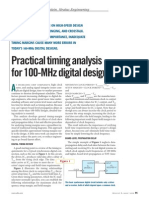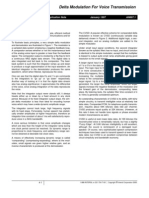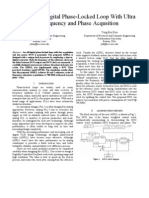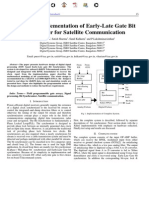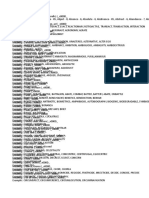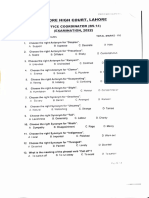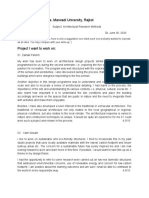Picosecond-Accuracy Digital-To-Time Converter For Phase-Interpolation Dds
Picosecond-Accuracy Digital-To-Time Converter For Phase-Interpolation Dds
Uploaded by
Mark William Sanchez PalaciosCopyright:
Available Formats
Picosecond-Accuracy Digital-To-Time Converter For Phase-Interpolation Dds
Picosecond-Accuracy Digital-To-Time Converter For Phase-Interpolation Dds
Uploaded by
Mark William Sanchez PalaciosOriginal Title
Copyright
Available Formats
Share this document
Did you find this document useful?
Is this content inappropriate?
Copyright:
Available Formats
Picosecond-Accuracy Digital-To-Time Converter For Phase-Interpolation Dds
Picosecond-Accuracy Digital-To-Time Converter For Phase-Interpolation Dds
Uploaded by
Mark William Sanchez PalaciosCopyright:
Available Formats
35th Annual Precise Time and Time Interval (PTTI) Meeting
PICOSECOND-ACCURACY DIGITAL-TO-TIME CONVERTER FOR PHASE-INTERPOLATION DDS
F. Baronti, D. Lunardini, R. Roncella, and R. Saletti Dipartimento di Ingegneria dellInformazione Via Caruso 2, 56122 Pisa, Italy Tel: +39-050-2217629; Fax: +39-050-2217522 E-mail: d.lunardini@iet.unipi.it
Abstract A high-resolution CMOS Digital-to-Time Converter for Direct-Digital-Synthesis (DDS) applications is presented in this paper. The novel architecture permits one to perform 4096 phase-interpolation levels introducing a delay proportional to a 12-bit digital control word with a resolution of about 2 ps. The virtual multiplication of the 120 MHz accumulator clock frequency by the factor 4096 is, thus, realized achieving a great reduction of the DDS output spurious components. The phase interpolation, implemented in two steps, is based on Delay-Locked Delay-Lines that are able to assure the reliability of the introduced delay by fully compensating environmental and process variations. The circuit is very compact in terms of occupied silicon area, since it employs only 35 delay-cells.
I. INTRODUCTION
Direct Digital Synthesis (DDS) is a popular technique commonly used in a wide range of applications such as measurement equipment, multistandard digital television, arbitrary waveform synthesis, FM or PM modulation, and very finely tunable clock generators. DDS solutions are becoming now suitable also for agile frequency generation in advanced wireless communication systems, instead of analog Phase-Locked Loops (PLL), especially for fully integrated implementations. PLL-based systems are able to provide high frequency output, spectral purity, and low power consumption, but, due to their feedback loop architecture, it is difficult to provide fast frequency switching and high frequency resolution at the same time. Nevertheless, present communication systems often require a high channel switching flexibility, so that the simultaneous achievement of both features is now becoming crucial in frequency synthesis. DDS-based circuits do not have the limitation in frequency switching speed, because the frequency is generated directly, without feedback loop, but they traditionally suffer the drawbacks of high power consumption and low operating frequency, at least in their basic implementation. A block diagram of a conventional DDS, capable of generating a sine wave, is reported in Figure 1. It consists of a phase accumulator, a ROM storing the sine values (LUT), and a D/A converter followed by a low-pass filter (LPF) [1]-[3]. A square wave can be obtained by adding a high-speed comparator.
PHASE ACC.
SINE LUT
D/A
LPF
OUT
Figure 1. Conventional DDS block diagram.
347
35th Annual Precise Time and Time Interval (PTTI) Meeting The phase accumulator provides the sine argument that is used as the ROM address. Every clock cycle, the corresponding sine value stored in the ROM is first read and then converted to an analog value. Once the undesired frequency components are filtered out, the consecutive analog values form the sine wave. If N is the number of bits of the accumulator output and P is the accumulator step (frequency control word), the output frequency is given by
f OUT =
P f CLK 2N
(1)
where CLK = 1/TCLK is the operating clock frequency. The clock frequency of the synthesizer is limited by the ROM access time and most of the power dissipation is due to the ROM and the D/A converter (DAC). The maximum operating speed of the analog parts of the DDS (DAC and filter) is far below that of the digital parts. In addition, CMOS integration of analog parts is difficult, especially with low power-supply voltages. Therefore, completely digital DDS architectures that use neither ROM nor D/A converter have been developed [4]-[8], in order to overcome the above-mentioned problems and to achieve higher generated frequencies. Several authors proposed eliminating the analog parts in DDS architectures by performing a phase interpolation of the clock period using a digitally controllable delay generator [4]-[7]. Phaseinterpolation DDS circuits are more suitable for integration and more easily transferable from a technology to another, because they do not contain complex analog parts, such as DACs. Moreover, the operating frequency is significantly improved with respect to traditional architectures, even if none of these circuits is able to generate a frequency higher than its input clock. A variant of the phase-interpolation DDS is the Direct Digital Period Synthesizer (DDPS) presented in [8]. In that case, the phase interpolation is combined with DLL-based frequency multiplication, thus allowing the generation of output frequencies higher than the input one. The drawback is that the control word is no longer proportional to the frequency but to the period of the output waveform. Both phase-interpolation DDS and the DDPS architectures employ a high resolution Digital-To-Time Converter (DTC), in order to finely locate every single edge of the output signal at the right instant in the time domain. Moreover, in both cases, the time resolution of the DTC directly determines the spectral purity of the produced output signal. A high-resolution DTC has been designed for phaseinterpolation DDS architectures and is addressed in this paper. According to post-layout simulations, the circuit is able to perform a 4096 level interpolation of a 120 MHz clock, reaching a delay resolution of about 2 ps. The delay generation is made in two steps. The first is a classic clock interpolator that consists in a 32-tap Delay-Locked Delay-Line (DLL) followed by a 32-to-1 multiplexer. The second stage is a new-concept delay generator based on the use of novel controllable delay-cells that can also be reused in DDPS architectures as the final delay regulator. The new delay-cell design, in which a current-starving digital control method is combined with the shunt-capacitor technique, allows the realization in the second stage of further 128 interpolation levels, also compensating at the same time the environmental condition changes. The following section gives a brief description of the phase-interpolation DDS architecture, whereas in Section III the new digitally controllable delay generator is presented. Finally, Section IV is devoted to the simulation results.
II. PHASE-INTERPOLATION DDS
By considering the traditional DDS architecture depicted in Figure 1, we realize that a signal present after the first block is characterized by a frequency equal to the desired output one, at least as a mean
348
35th Annual Precise Time and Time Interval (PTTI) Meeting value. Actually, provided that the frequency control word (P) is an odd number, the pulse width of the most significant bit (MSB) of the phase accumulator output changes periodically with a period of 2N/CLK, since the output sequence repeats itself every 2N clock cycles. In this period, the number of pulses of MSB are exactly P, so the mean frequency of the considered signal is indeed already equal to OUT defined in (1). That signal is a rectangular wave, but the fundamental frequency can be extracted by a low-pass filter in the applications in which a sine wave is needed. Therefore, the phase accumulator alone can be considered as a rough DDS circuit. However, the position in the time domain of the signal edges is quantized by the system clock period, so that high spurious components are generated in the waveform spectrum. These values of the spurious components are actually unacceptable in most of the applications. Once the output frequency is fixed, a trivial way to reduce the spurious frequency components is increasing the system clock frequency. However, the limit is the maximum working frequency of the phase accumulator that cannot be overtaken. A great improvement of the output spectral purity can also be obtained by delaying each edge of the output signal independently, with a precise controllable delay generator (DTC), in order to make all the output pulses of the same width. Figure 2 presents a simplified block diagram of the phase-interpolation DDS architecture.
MSB P PHASE ACC. C
DIGITAL TO TIME CONVERTER K
OUT
C K = 1 M P
Figure 2. Block diagram of the phase-interpolation DDS general architecture. MSB edges are each one delayed by the indicated quantity. The delay that must be applied to each edge of MSB can be deduced directly from the phase information carried by the N 1 least significant bits of the phase accumulator output (C in the figure), once that the number M of interpolation levels implemented by the delay generator is known. An example of the output waveform generation for the first 2N+1 clock cycles is shown in Figure 3. The figure refers to the simple case in which N = 3 and P = 3 and shows how the ideal output waveform can be generated by properly delaying each rising and falling edge of the MSB waveform. The precision of the performed time interpolation and, consequently, the level of the output spurious signals depend now only on the accuracy of the DTC. Indeed, the position of the waveform edges at the output of the delay generator is no longer quantized by the system clock period, but is now quantized by the DTC resolution. It is worth noting that the effect of the phase interpolation on the output signal spectral purity is the same as increasing the clock frequency in the phase accumulator. In particular, performing an M-level phase interpolation is equivalent to a virtual clock multiplication by a factor M. The key factor is now the design of a DTC with the required precision. The use of digitally controlled delay-locked delay-lines (DLL) permits one to realize the phase-interpolation circuit with outstanding performance, so that very low spurious levels can be obtained [9].
349
35th Annual Precise Time and Time Interval (PTTI) Meeting
Time (TCLK) 1 2 3 4 5 6 7 8 9
Acc. Out. 0 3 6 1 4 7 2 5 0
MSB 0 0 1 0 1 1 0 1 0
Delay (TCLK/N) 1 2 3 1 2 3
MSB Output Waveform Waveform
Figure 3. Example of Digital Direct Synthesis with ideal phase interpolation, using a three-bit phase accumulator, when P = 3.
III. DIGITAL-TO-TIME CONVERTER
A basic block diagram of the novel two-stage Digital-to-Time Converter is shown in Figure 4. The first stage of the delay generation is responsible for the first 32 interpolation levels. It consists of a DLL locked to the clock period, followed by a multiplexer. The 32-tap DLL consists of a cascade of 32 elemental adjustable delay-cells that is inserted in a negative feedback loop by which the line delay is kept equal to the period of the input clock (TCLK). The variations of process conditions, power supply, and temperature are, thus, compensated. Each cell of the delay-line is designed using a shunt-capacitor circuit scheme [10], so that the delay control can be carried out by a fully digital semi-custom controller. The DLL produces 32 output signals replicating the input one, each one spaced in phase from the other by TCLK/32. The following multiplexer permits one to choose one of the DLL outputs that is then used as the synchronization signal for the MSB waveform coming from the phase accumulator. Given the clock frequency of 120 MHz in this design example, the time resolution reached by this first stage is about 260 ps, which is also the delay introduced by each cell of the delay line.
1st stage Clk 2nd stage
FINE DELAY GENERATOR
DLL
32 to 1 MUX
MSB K
12 7 5
D Q
D Q
Out
Figure 4. Two-step Digital-to-Time Converter (simplified block diagram). 350
35th Annual Precise Time and Time Interval (PTTI) Meeting The second step of the delay generator is a novel architecture that is able to realize a further 128-level interpolation inside each delay tap provided by the first step. Since the DDS application is insensitive to a delay offset identically applied to any signal edge, the first idea is to exploit the difference between two delays instead of the whole delay of a cell. In brief, a single delay-adjustable cell is used to introduce the desired delay by changing between different load configurations. However, this additional delay-cell suffers the environmental and process changes that strongly affect the introduced delay. In order to also make this fine delay generator able to compensate for the changes in environmental conditions, without reducing the precision of the introduced delay, a new kind of controllable delay-cell is employed. Before analyzing in detail the fine delay generator structure, the delay-cell architecture must be presented.
CURRENT-STARVED/SHUNT-CAPACITOR DELAY-CELL
The delay-cells used in the second stage of the delay generator consist of two cascaded inverters, as for any other traditional delay-cell, but their delay needs to be controlled in a particularly flexible way. The next sub-section will explain in detail how this delay control flexibility is used to obtain both a very-high-output delay resolution and accurate compensation of the environmental variations at the same time. Two main techniques are usually employed to make the delay of the cell controllable by an external signal. Essentially, the desired result can be reached by acting either on the inverters load (shunt-capacitors) or on the inverters strength (current-starving). In the newly developed delaycell presented in this work, both the methods are exploited. Figure 5 shows one of the two identical inverters composing the cell. The MOS transistors MN0-MN4 and MP0-MP4 have been designed with binary-weighted increasing widths, and they can be switched on or off by the five-bit control word C0C4. In this way, the current- starving control is completely digital and the strength of the inverters can be regulated with 32 possible control steps. Moreover, a set of 127 shunt-capacitors is connected at the output of the inverter. A shunt-capacitor is a MOS transistor in which the source and drain terminals are joined together and attached to the inverter output. The digital voltage applied at the gate terminal decides if the MOS channel is formed or not, so that the channel capacitance is inserted or removed according to the gate voltage logic value. The 127 transistor/capacitors are all identical each other, but their control signals (gates) are organized in binary-weighted groups in order to make the load controllable by a seven-bit digital control word. Therefore, the most significant bit of the control word drives 64 shunt-capacitors, whereas only one capacitor is controlled by the least significant bit.
SECOND STAGE FINE DELAY-GENERATOR
The novel architecture of the circuit that implements the second stage of the phase interpolation is showed in Figure 6 as a simplified block diagram. The circuit is essentially composed of three identical delay-cells of the type just described in the previous sub-section. The third cell is responsible for the fine delay generation, whereas the two others are in charge of stabilizing the delay introduced by the third cell against environmental and process variations. As it can be seen in the figure, the current-starving control is identical for all the three cells. It is managed by a digital controller circuit that carries out in parallel the feedback correction according to the result of the phase comparison between the first two cell outputs. On the other hand, the shunt-capacitor configurable load is controlled in a different way for each cell.
351
35th Annual Precise Time and Time Interval (PTTI) Meeting
Vdd
MP0 MP1 MP2 MP3 MP4
/C0
/C1
/C2
/C3
/C4
Shunt Capacitor D/S
IN
OUT
MN0
MN1
MN2
MN3
MN4
127 Configurable Capacitors
Control word
7
C0
C1
C2
C3
C4
Figure 5. Current-starving/shunt-capacitor delay-cell with double digital control. In particular, all the shunt-capacitors of the first cell are always switched off, so that the cell is configured to introduce the minimum possible delay (MIN). Instead, all the capacitors of the second cell are always switched on and the introduced delay is the maximum (MAX). The input of these cells is connected to two adjacent taps of the serial delay-line (first stage of the delay generator). The negative feedback loop acting on the current-starving control keeps in phase the outputs of the first and second cell. Therefore, the difference between MAX and MIN is maintained constant and equal to the serial delay-line cell delay, compensating the environmental changes. Since the control is in common to all the three cells, the delay is also stabilized in the third cell, provided that their behavior is supposed to be identical. The feedback loop is implemented by a high-sensible phase comparator (PC) and a simple digital controller. The following equation is satisfied when the loop is locked:
MAX MIN = SER
(1)
where SER is the delay introduced by one cell of the serial delay line used to implement the first delay stage. In order to understand better how the equation (1) can be satisfied only controlling the currentstarving transistors, let us consider a first order approximation of the delay introduced by a generic inverter:
= RC
(2)
where R is inversely proportional to the inverter strength and C represent inverter load. Considering the loads of the first two cells of our system, the difference between their delays can be written as
SER = MAX MIN = R (C 0 + C ) R C 0 = R C
(3)
when the current-starving feedback loop is locked, where C0 stands for the load of the first cell (all the shunt capacitors switched off) and C is the extra-load introduced by all the 127 shunt capacitors. It is now clear that equation (3) can be satisfied by regulating only the strength of the transistors (R), that is to say controlling the current-starving transistors. 352
35th Annual Precise Time and Time Interval (PTTI) Meeting
SER
MIN MAX
5 IN Digital Input 7
PC
CURRENT STARVING CONTROL
EFF
OUT
Figure 6. Block diagram of the fine delay-generator, 2nd stage of the phase interpolation. The strategy of compensating the environmental changes operating only with the current-starving control permits one to reserve the whole digital shunt-capacitor control of the third cell to generate the desired delay. Indeed, once the current-starving control loop is locked, the only difference between the second and the first cell is that the 127 shunt-capacitors are switched on and off respectively. Therefore, the difference in the introduced delay is now completely due to the capacitors. That means that a 128-level interpolation is realized by simply controlling the seven-bit digital control word that commands the number of capacitors inserted in the third cell. It is also worth noting that the 128 steps are obtained using only three delay-cells, so that only 35 active delay-cells are sufficient to achieve the 4096-level interpolation.
IV. SIMULATION RESULTS
The Digital-to-Time Converter has been completely designed and extensively simulated using a 0.35 m CMOS technology. In particular, the second stage of the delay generation has been functionally verified and carefully characterized after the layout phase, since it is the major novelty of this work. Figure 7 shows the post-layout simulation results relevant to the difference between the delays introduced by the second and the first cell of the fine delay generator as a function of the current-starving control. It is worth noting that a delay difference of 260 ps can always be reached in every environment or process condition. The simulation shown in Figure 8 demonstrates the linearity of the shunt-capacitors digital control, once that the current-starving feedback loop is locked. It can be observed that, since the current-starving control steps are very small, the phase comparator (PC) must be able to distinguish very slight phase variations. Particular attention has been paid in the layout design in order to avoid undesired differences in the delay paths, especially for the 32-to-1 multiplexer of the first stage. A few dummy cells were inserted to synchronize the signals and to limit nonlinearity effects. As an example of the achievable spectral purity enhancement with the described system, the spectrum of a 37 MHz output signal with and without phase interpolation is shown in Figure 9. It must be noted that those simulations refer to the ideal case in which nonlinearity effects are not taken into account.
353
35th Annual Precise Time and Time Interval (PTTI) Meeting
500 450 Delay Difference (ps) 400 350 300 250 200 150 100 1 4 7 10 13 16 19 22 25 28 Digital Current Starving Control 31 Typical Mean Worst power Worst speed
Figure 7. Post-layout simulation of the delay difference between the second and the first cell in the fine delay generator as a function of the current-starving digital control. The value of SER = 260 ps is reached in every environment and process condition.
250 Delay difference (ps) 200 150 100 50 0 0 10 20 30 40 50 60 70 80 90 100 110 120
Digital Shunt-Capacitor Control
Figure 8. Post-layout simulation of the delay difference introduced by the third cell of the fine delay generator as a function of the shunt capacitor control, with respect to the delay introduced when all the configurable loads are switched off. However, despite all the possible efforts in the layout design, a residual nonlinearity always remains especially due to the unavoidable circuital random mismatch. These effects introduce undesired phase modulation in the DDS output signal and directly affect the output spectral purity. However, a possible solution to overcome the problem consists in adopting calibration techniques to reduce the delay-line nonlinearity [11].
354
35th Annual Precise Time and Time Interval (PTTI) Meeting
20 0 -20 -40
dB
-60 -80 -100 -120 0 10 20 30 40 50 60 70
f (MHz)
20 0 -20 -40
dB
-60 -80 -100 -120 0 10 20 30
f (MHz)
40
50
60
70
Figure 9. Spectrum of a 37 MHz output signal before and after the 4096 level phase interpolation.
V. CONCLUSION
A very-high-resolution digital-to-time converter for phase-interpolation DDS architectures has been designed with a 0.35 m CMOS technology. It consists of two cascaded delay stages, the first of which is based on a DLL, capable of generating a delay proportional to a 12-bit control word. A novel delay-cell design with a double digital delay control is introduced in the second stage of the delay generation in order to reach 128-level interpolation using only three delay-cells. The system achieves 4096 levels of interpolation with a delay resolution of about 2 ps, compensating at the same time the variations of the operating conditions. As a result, the whole circuit is very compact in terms of occupied silicon area, since the total number of delay-cells is only 35.
ACKNOWLEDGMENT
The authors wish to acknowledge Andrea Calleri for a valuable contribution in the development of this work.
REFERENCES
[1] H. T. Nicholas III and H. Samueli, 1991, A 150 MHz Direct Digital Synthesizer in 1.25-m CMOS with 90 dBc Spurious Performance, IEEE Journal of Solid State Circuits, 26, 19591969.
355
35th Annual Precise Time and Time Interval (PTTI) Meeting [2] A. Yamagishi, M. Ishikawa, T. Tsukahara, and S. Date, 1998, A 2-V, 2-GHz Low-Power Direct Digital Frequency Synthesizer Chip-Set for Wireless Communication, IEEE Journal of Solid State Circuits, 33, 210-217. [3] J. Vankka, M. Waltari, M. Kosunen, and K. A. I. Halonen, 1998, A direct digital synthesizer with an on-chip D/A-converter, IEEE Journal of Solid State Circuits, 33, 218-227. [4] T. Nakagawa and H. Nosaka, 1997, A Direct Digital Synthesizer with Interpolation Circuits, IEEE Journal of Solid State Circuits, 32, 766-769. [5] A. Heiskanen, A. Mantyniemi, and T. Rahkonen, 2001, A 30 MHz DDS clock generator with sub-ns time domain interpolator and -50 dBc spurious level, in Proceedings of ISCAS 2001, the 2001 IEEE International Symposium on Circuits and Systems, vol. 4, pp. 626-629. [6] H. Nosaka, Y. Yamaguchi, A. Yamagishi, H. Fukuyama, and M. Muraguchi, 2001, A Low-Power Direct Digital Synthesizer Using a Self-Adjusting Phase-Interpolation Technique, IEEE Journal of Solid State Circuits, 36, 1281-1285. [7] R. Richter and H. J. Jentschel, 2001, A Virtual Clock Enhancement Method for DDS Using an Analog Delay Line, IEEE Journal of Solid State Circuits, 36, 1158-1161. [8] D. E. Calbaza and Y. Savaria, 2002, A Direct Digital Period Synthesis Circuit, IEEE Journal of Solid State Circuits, 37, 1039-1045. [9] F. Baronti, D. Lunardini, L. Fanucci, R. Roncella, and R. Saletti, 2002, A High-Resolution DLLbased Digital-to-Time converter for DDS Applications, in Proceedings of 2002 IEEE International Frequency Control Symposium and PDA Exhibition, 29-31 May 2002, New Orleans, Louisiana, USA (IEEE Publication 02CH37234), pp. 649-653. [10] P. Andreani, F. Bigongiari, R. Roncella, R. Saletti, and P. Terreni, 1999, A digitally controlled shunt capacitor CMOS delay line, Analog and Integrated Circuit and Signal Processing, 18, 89-96. [11] F. Baronti, D. Lunardini, R. Roncella, and R. Saletti, A Self-Calibrating Delay-Locked Delay-Line with Shunt-Capacitor Circuit Scheme, IEEE Journal of Solid State Circuits, 39, no. 2 (in press).
356
35th Annual Precise Time and Time Interval (PTTI) Meeting
QUESTIONS
AND
ANSWERS
JOHN PETSINGER (ITT): What was the spur reduction? It went from minus 10 to minus what? It looked like minus 80 from back here. DIEGO LUNARDINI: It was only an example of a 37 MHz signal synthesizing before and after the phase interpolation. The first one was the output of the phase accumulator, the MSB. The second spectrum is the spectrum of the final output signal. PETSINGER: Yes, but what exactly was the reduction? LUNARDINI: It was from minus 10 dB to minus 82 dB.
357
35th Annual Precise Time and Time Interval (PTTI) Meeting
358
You might also like
- Analysis of Fertilizer Industry of PakistanDocument59 pagesAnalysis of Fertilizer Industry of PakistanMaryam97% (30)
- ACSM's Complete Guide To Fitness & Health, 2E - American College of Sports Medicine, Bushman, BarbaraDocument1,289 pagesACSM's Complete Guide To Fitness & Health, 2E - American College of Sports Medicine, Bushman, BarbaraAntónio Cardoso100% (2)
- Solubility FESO4Document9 pagesSolubility FESO4Jesse JohnsonNo ratings yet
- A 2.6Ps - Period-Jitter 900Mhz All-Digital Fractional-N PLL Built With Standard CellsDocument4 pagesA 2.6Ps - Period-Jitter 900Mhz All-Digital Fractional-N PLL Built With Standard CellsRichard SuNo ratings yet
- A O.8ps Minimum-Resolution Sub-Exponent TDC For ADPLL in O.13Jlm CMOSDocument4 pagesA O.8ps Minimum-Resolution Sub-Exponent TDC For ADPLL in O.13Jlm CMOSApikShafieeNo ratings yet
- High Resolution Digital-To-Time Converter For Low Jitter Digital PllsDocument4 pagesHigh Resolution Digital-To-Time Converter For Low Jitter Digital PllsroomaNo ratings yet
- Dds IntroDocument6 pagesDds IntroYermakov Vadim IvanovichNo ratings yet
- A Wide-Range, High-Resolution, Compact, CMOS Time To Digital ConverterDocument6 pagesA Wide-Range, High-Resolution, Compact, CMOS Time To Digital ConverterShruti KalraNo ratings yet
- Fully Digital Hysteretic Modulator For DC-DC Switching ConvertersDocument8 pagesFully Digital Hysteretic Modulator For DC-DC Switching ConvertersAnand RamamurthyNo ratings yet
- 2.9 A Background Calibration Technique To Control Bandwidth in Digital PLLsDocument3 pages2.9 A Background Calibration Technique To Control Bandwidth in Digital PLLsshexu515No ratings yet
- An Improved Analog Waveforms Generation Technique Using Direct Digital SynthesizerDocument4 pagesAn Improved Analog Waveforms Generation Technique Using Direct Digital SynthesizerezanaNo ratings yet
- A 2.4GHz 2Mbs Digital PLL-Based Transmitter For 802.15.4 in 130nm CMOSDocument4 pagesA 2.4GHz 2Mbs Digital PLL-Based Transmitter For 802.15.4 in 130nm CMOSraja_ramalingam07No ratings yet
- PLL DividerDocument6 pagesPLL Divider081270No ratings yet
- TDC SSCL FinalDocument4 pagesTDC SSCL FinalRohish Kumar Reddy mittaNo ratings yet
- A Programmable Delay LineDocument3 pagesA Programmable Delay Line3522874398No ratings yet
- Simplified Analogue Realization of The Digital Direct Synthesis (DDS) Technique For Signal GenerationDocument5 pagesSimplified Analogue Realization of The Digital Direct Synthesis (DDS) Technique For Signal GenerationInternational Organization of Scientific Research (IOSR)No ratings yet
- TimingDocument6 pagesTimingRaj NikumbhNo ratings yet
- Excess Loop Delay in Continuous-Time Delta-Sigma Modulators: James A. Cherry,, and W. Martin SnelgroveDocument14 pagesExcess Loop Delay in Continuous-Time Delta-Sigma Modulators: James A. Cherry,, and W. Martin Snelgrovebhargav nagarajuNo ratings yet
- Key-Words: DDFS, Direct-Digital Frequency Synthesizer, Nonuniform SegmentationDocument68 pagesKey-Words: DDFS, Direct-Digital Frequency Synthesizer, Nonuniform SegmentationKarthik MohanNo ratings yet
- OFDM Versus Single Carrier With Cyclic Prefix: A System-Based Comparison For Binary ModulationDocument4 pagesOFDM Versus Single Carrier With Cyclic Prefix: A System-Based Comparison For Binary ModulationKieu HuongNo ratings yet
- Design of An ADC Using High Precision Comparator With Time Domain Offset CancellationDocument4 pagesDesign of An ADC Using High Precision Comparator With Time Domain Offset CancellationijtetjournalNo ratings yet
- 2021 ASSCC-A 4th-Order CT I-DSM With Digital Noise Coupling and Input Pre-Conversion Method For InitializationDocument3 pages2021 ASSCC-A 4th-Order CT I-DSM With Digital Noise Coupling and Input Pre-Conversion Method For Initialization송관훈No ratings yet
- Digital High Order Multiplier-Free Delta Sigma Modulator For Multistandard Fractional-N Frequency SynthesizerDocument8 pagesDigital High Order Multiplier-Free Delta Sigma Modulator For Multistandard Fractional-N Frequency SynthesizerMehdi TzNo ratings yet
- A 1.8V 12-Bit 230-MS/s Pipeline ADC in 0.18 M CMOS TechnologyDocument4 pagesA 1.8V 12-Bit 230-MS/s Pipeline ADC in 0.18 M CMOS Technologyfaithfully_fatihNo ratings yet
- Delta Modulation For Voice Transmission: Application Note January 1997 AN607.1Document6 pagesDelta Modulation For Voice Transmission: Application Note January 1997 AN607.1Mac AnciadoNo ratings yet
- A Low Power A - D Converter 05613669Document4 pagesA Low Power A - D Converter 05613669Romualdo Begale PrudêncioNo ratings yet
- Application High Speed Digital To Analog ConverterDocument6 pagesApplication High Speed Digital To Analog ConverterSheida FarajiNo ratings yet
- A 2GS/s 9-Bit 8-12x Time-Interleaved Pipeline-SAR ADC For A PMCW Radar in 28nm CMOSDocument4 pagesA 2GS/s 9-Bit 8-12x Time-Interleaved Pipeline-SAR ADC For A PMCW Radar in 28nm CMOSburakgonenNo ratings yet
- A New ADPLLDocument4 pagesA New ADPLLTruegodman FangNo ratings yet
- RTS Noise Impact in CMOS Image Sensors Readout CircuitDocument5 pagesRTS Noise Impact in CMOS Image Sensors Readout CircuiturpublicNo ratings yet
- Video PDFDocument15 pagesVideo PDFApikShafieeNo ratings yet
- All Digital Timing Recovery and FPGA Implementation: Daniel Cárdenas, Germán ArévaloDocument6 pagesAll Digital Timing Recovery and FPGA Implementation: Daniel Cárdenas, Germán Arévalom0hmdNo ratings yet
- Phase AccumulatorsDocument4 pagesPhase AccumulatorsMuhammad AbbasNo ratings yet
- Chapter 3Document42 pagesChapter 3Cu BomNo ratings yet
- TI Data Converter GuideDocument16 pagesTI Data Converter GuideDavid PostonNo ratings yet
- 3412 Vlsics 07Document14 pages3412 Vlsics 07Zubair MohammedNo ratings yet
- Communication ManualDocument47 pagesCommunication ManualAbinav anilNo ratings yet
- A High Linearity FMCW Sweep GeneratorDocument10 pagesA High Linearity FMCW Sweep GeneratorDong-hun ShinNo ratings yet
- A Fast-Lock Mixed-Mode DLL With Wide-Range Operation and Multiphase OutputsDocument4 pagesA Fast-Lock Mixed-Mode DLL With Wide-Range Operation and Multiphase OutputsAbhishek MinniNo ratings yet
- Zero CrossingDocument3 pagesZero CrossingFrank M CNo ratings yet
- Digital Signal Synthesis DDS - Tutorial - Rev12!2!99Document122 pagesDigital Signal Synthesis DDS - Tutorial - Rev12!2!99Lixo4618No ratings yet
- Term Paper of EleDocument8 pagesTerm Paper of Eleshailesh singhNo ratings yet
- Design and Implementation of Early-Late Gate Bit Synchronizer For Satellite CommunicationDocument4 pagesDesign and Implementation of Early-Late Gate Bit Synchronizer For Satellite CommunicationMatthew CarterNo ratings yet
- Design and Implemation of An Enhanced Dds Based Digital Modulator For Multiple Modulation Schemes Manoj Kollam, S.A.S Krishna Chaithanya and Nagaraju Kommu IJSSAN 2011Document6 pagesDesign and Implemation of An Enhanced Dds Based Digital Modulator For Multiple Modulation Schemes Manoj Kollam, S.A.S Krishna Chaithanya and Nagaraju Kommu IJSSAN 2011John JohnstonNo ratings yet
- Direct Digital Frequency Synthesizer With CORDIC AlgorithmDocument12 pagesDirect Digital Frequency Synthesizer With CORDIC AlgorithmYermakov Vadim Ivanovich0% (1)
- DC Lab-MinDocument71 pagesDC Lab-MinKiran U NNo ratings yet
- Implementation of Digital QPSK Modulator by Using VHDL / MatlabDocument5 pagesImplementation of Digital QPSK Modulator by Using VHDL / Matlabblesson123No ratings yet
- Great DLL ArticleDocument13 pagesGreat DLL ArticleRashidHamdaniNo ratings yet
- A Highly-Efficient Multi-Band Multi-Mode Digital Quadrature Transmitter With 2D Pre-DistortionDocument4 pagesA Highly-Efficient Multi-Band Multi-Mode Digital Quadrature Transmitter With 2D Pre-DistortionSMBNo ratings yet
- S.Kalaivanan N.Sathishkumar K.Ram PrakashDocument5 pagesS.Kalaivanan N.Sathishkumar K.Ram PrakashSaud ManzarNo ratings yet
- 12EC62R20 Ramesh SynopsisDocument9 pages12EC62R20 Ramesh Synopsisprasad72207No ratings yet
- 180.5Mbps-8Gbps DLL-based Clock and Data Recovery Circuit With Low Jitter PerformanceDocument4 pages180.5Mbps-8Gbps DLL-based Clock and Data Recovery Circuit With Low Jitter PerformanceMinh KhangNo ratings yet
- High Speed Direct Digital Frequency Synthesizer Using A New Phase AccumulatorDocument5 pagesHigh Speed Direct Digital Frequency Synthesizer Using A New Phase AccumulatorYermakov Vadim IvanovichNo ratings yet
- A Novel Low Power Digitally Controlled Oscillator With Improved Linear Operating RangeDocument6 pagesA Novel Low Power Digitally Controlled Oscillator With Improved Linear Operating RangeNandhini IlangovanNo ratings yet
- A DSP Implementation of OFDM Acoustic ModemDocument4 pagesA DSP Implementation of OFDM Acoustic ModemrettyrajaNo ratings yet
- R - KZ I: A 12-Bit ADC Successive-Approximation-Type With Digital Error CorrectionDocument10 pagesR - KZ I: A 12-Bit ADC Successive-Approximation-Type With Digital Error CorrectionMiguel BrunoNo ratings yet
- Performance Analysis of OFDM For Different Modulation TechniquesDocument6 pagesPerformance Analysis of OFDM For Different Modulation Techniquesrahman08413No ratings yet
- Low Power Nine-Bit Sigma-Delta ADC Design Using TSMC 0.18micron TechnologyDocument5 pagesLow Power Nine-Bit Sigma-Delta ADC Design Using TSMC 0.18micron Technologyeditor_ijtel100% (1)
- A 1.8Ghz Cmos: Low-Power Truly-Modular Programmable Divider in Standard TechnologyDocument4 pagesA 1.8Ghz Cmos: Low-Power Truly-Modular Programmable Divider in Standard TechnologyMuhammad_Swilam_2010No ratings yet
- DC 21 564 568 PDFDocument5 pagesDC 21 564 568 PDFlambanaveenNo ratings yet
- High-Performance D/A-Converters: Application to Digital TransceiversFrom EverandHigh-Performance D/A-Converters: Application to Digital TransceiversNo ratings yet
- I6s UPS Catalogue (Domestic)Document8 pagesI6s UPS Catalogue (Domestic)SagarNo ratings yet
- RootwordDocument100 pagesRootwordnagaraja h i100% (1)
- Natalia, No 42 (2012)Document168 pagesNatalia, No 42 (2012)Peter CroeserNo ratings yet
- Im 4 Activities and AssignmentsDocument1 pageIm 4 Activities and AssignmentsAngel Mae Ob-aronNo ratings yet
- Coast Residencesdhiyt PDFDocument2 pagesCoast Residencesdhiyt PDFFrantzenFrantzen78No ratings yet
- Lesson Plan Template - Integrated Curriculum Unit: Lauren Moss Curriculum Content Areas: Physical ScienceDocument5 pagesLesson Plan Template - Integrated Curriculum Unit: Lauren Moss Curriculum Content Areas: Physical Scienceapi-531832766No ratings yet
- Gas Tanker ProjectDocument40 pagesGas Tanker ProjectJudson FarrayNo ratings yet
- Underground Obstacle RemovalDocument11 pagesUnderground Obstacle RemovalhutuguoNo ratings yet
- Lahore High Court Office CoordinatorDocument8 pagesLahore High Court Office CoordinatorQamar AbbasNo ratings yet
- PT Ro 04 11083Document183 pagesPT Ro 04 11083jayendrapatilNo ratings yet
- 2 Support and Resistance 2Document1 page2 Support and Resistance 2philipwijaya00032No ratings yet
- DCPD - SoftSkills Reappear External VIVA Schedule - Nov'23Document2 pagesDCPD - SoftSkills Reappear External VIVA Schedule - Nov'23Mohd YusufNo ratings yet
- Recording 1979 04Document168 pagesRecording 1979 04Anonymous F6eJWM100% (1)
- THE MIRROR OF ART: REFLECTIONS ON TRANSFERENCE AND THE GAZE OF THE PICTURE - Joy SchaverienDocument20 pagesTHE MIRROR OF ART: REFLECTIONS ON TRANSFERENCE AND THE GAZE OF THE PICTURE - Joy SchaverienPaula Grillo100% (1)
- Hstory of Science Philosophy and Culture ListDocument4 pagesHstory of Science Philosophy and Culture ListAnonymous LsyWN2oJNo ratings yet
- Architectural Research Methods ReportDocument7 pagesArchitectural Research Methods ReportMayur KotechaNo ratings yet
- Railway TechnicalDocument440 pagesRailway TechnicalFrancisco Abraham Baeza92% (13)
- MasterTop P 617 PTADocument15 pagesMasterTop P 617 PTAMaha MuflehNo ratings yet
- PEST Coca - ColaDocument2 pagesPEST Coca - ColaannadisNo ratings yet
- Geostatistics For Environmental ScientistDocument15 pagesGeostatistics For Environmental ScientistFrancisco Javier Ceballos AravenaNo ratings yet
- HPE Solid State Disk Drives-A00001288enwDocument76 pagesHPE Solid State Disk Drives-A00001288enwmashiz tehraanNo ratings yet
- Report On Seal Harvest in Namibia 2012Document27 pagesReport On Seal Harvest in Namibia 2012LegalAction4AnimalRightsNo ratings yet
- Andrew Matthews-Happiness Now - VDocument30 pagesAndrew Matthews-Happiness Now - VmartinNo ratings yet
- Pain Management For NursesDocument42 pagesPain Management For Nursesblacknurse100% (1)
- Comparative and Superlative AdjectivesDocument15 pagesComparative and Superlative AdjectivesLIZBETH ARROYO DAMIANNo ratings yet
- Treatment of COD and Color by EC Process From Textile WastewatersDocument29 pagesTreatment of COD and Color by EC Process From Textile WastewatersKâmil VARINCANo ratings yet
- Quo Vadis Ethiopia? Scenarios-Executive-summery-final-EnglishDocument13 pagesQuo Vadis Ethiopia? Scenarios-Executive-summery-final-Englishሰሎሞን ገብረ ወልደኣናንያNo ratings yet
















